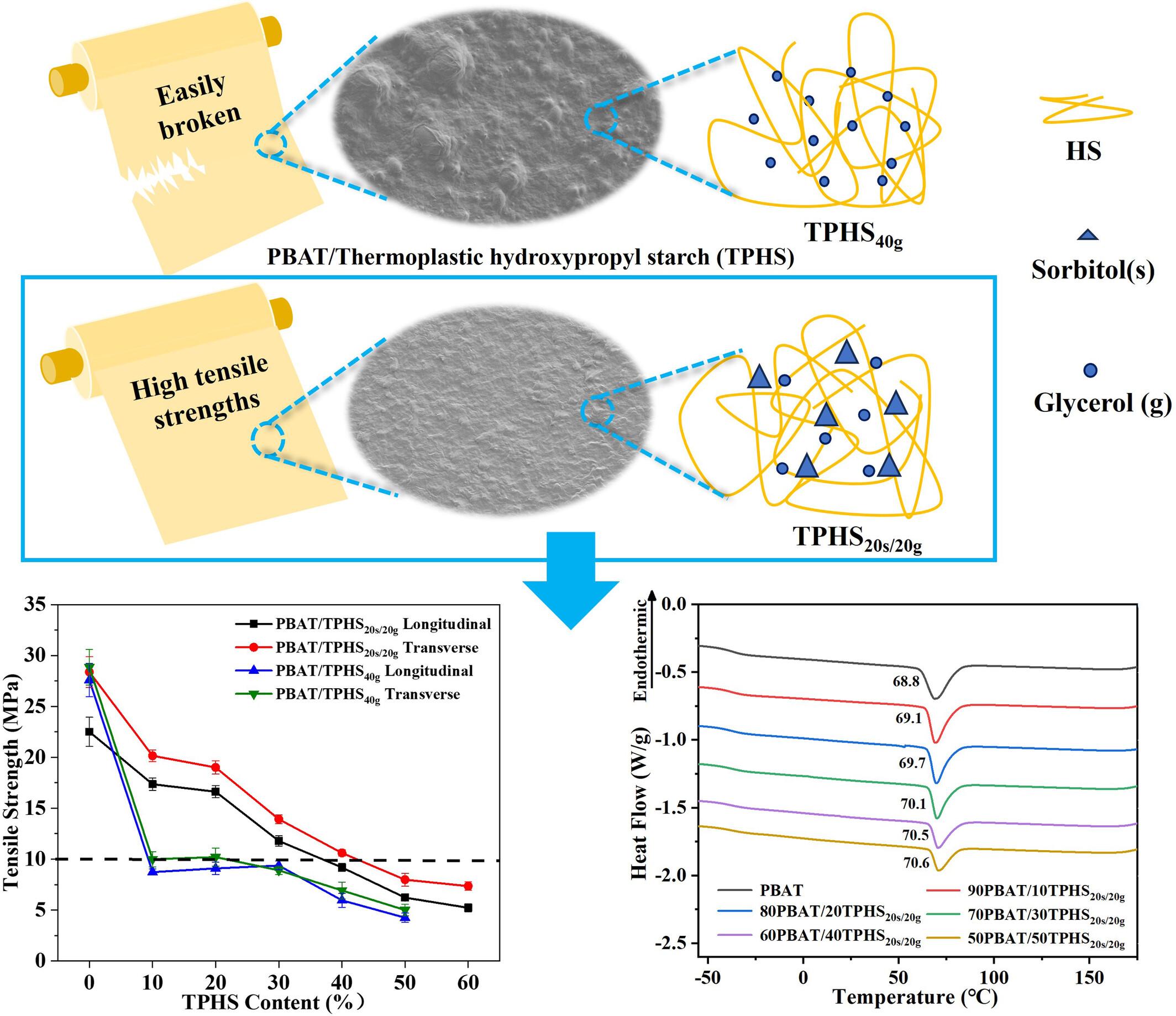求助PDF
{"title":"聚(己二酸丁二醇酯-对苯二甲酸丁二醇酯)/热塑性羟丙基淀粉薄膜的制备与性能","authors":"Muxi Wang, Zehao Li, Wenbo Zhao, Zhenyu Huang, Hong Liu, Li-Jun Ma, Liting Yang","doi":"10.1002/pi.6645","DOIUrl":null,"url":null,"abstract":"<p>Poly[(butylene adipate)-<i>co</i>-terephthalate] (PBAT) is currently the most widely used and versatile petroleum-based fully biodegradable polyester, drawing extensive attention from researchers. However, the high production cost of PBAT restricts its widespread application. Currently, incorporating fillers into PBAT materials is considered the most effective approach to reduce production costs, with thermoplastic starch recognized as the optimal filler for PBAT base materials. Nevertheless, the low mechanical strength of thermoplastic starch significantly compromises the performance of PBAT base materials. In this study, thermoplastic starch with higher mechanical strength was prepared by partially substituting commonly used glycerol with a higher molecular weight sorbitol as the plasticizer. The enhanced thermoplastic starch was then used as a filler for PBAT materials, leading to the fabrication of PBAT-based blend films with high starch content. Mechanical property tests revealed a 52.2% and 65.3% increase of tensile strength in the transverse and longitudinal directions, respectively, when sorbitol partially replaced glycerol as the plasticizer for thermoplastic starch. Scanning electron microscopy results demonstrated improved dispersion of thermoplastic starch particles in PBAT when sorbitol and glycerol were used together. Meanwhile, the thermal performance and stability of PBAT were not significantly affected by the thermoplastic starch filling. © 2024 Society of Chemical Industry.</p>","PeriodicalId":20404,"journal":{"name":"Polymer International","volume":"73 9","pages":"761-769"},"PeriodicalIF":2.9000,"publicationDate":"2024-04-25","publicationTypes":"Journal Article","fieldsOfStudy":null,"isOpenAccess":false,"openAccessPdf":"","citationCount":"0","resultStr":"{\"title\":\"Preparation and properties of poly[(butylene adipate)-co-terephthalate]/thermoplastic hydroxypropyl starch films\",\"authors\":\"Muxi Wang, Zehao Li, Wenbo Zhao, Zhenyu Huang, Hong Liu, Li-Jun Ma, Liting Yang\",\"doi\":\"10.1002/pi.6645\",\"DOIUrl\":null,\"url\":null,\"abstract\":\"<p>Poly[(butylene adipate)-<i>co</i>-terephthalate] (PBAT) is currently the most widely used and versatile petroleum-based fully biodegradable polyester, drawing extensive attention from researchers. However, the high production cost of PBAT restricts its widespread application. Currently, incorporating fillers into PBAT materials is considered the most effective approach to reduce production costs, with thermoplastic starch recognized as the optimal filler for PBAT base materials. Nevertheless, the low mechanical strength of thermoplastic starch significantly compromises the performance of PBAT base materials. In this study, thermoplastic starch with higher mechanical strength was prepared by partially substituting commonly used glycerol with a higher molecular weight sorbitol as the plasticizer. The enhanced thermoplastic starch was then used as a filler for PBAT materials, leading to the fabrication of PBAT-based blend films with high starch content. Mechanical property tests revealed a 52.2% and 65.3% increase of tensile strength in the transverse and longitudinal directions, respectively, when sorbitol partially replaced glycerol as the plasticizer for thermoplastic starch. Scanning electron microscopy results demonstrated improved dispersion of thermoplastic starch particles in PBAT when sorbitol and glycerol were used together. Meanwhile, the thermal performance and stability of PBAT were not significantly affected by the thermoplastic starch filling. © 2024 Society of Chemical Industry.</p>\",\"PeriodicalId\":20404,\"journal\":{\"name\":\"Polymer International\",\"volume\":\"73 9\",\"pages\":\"761-769\"},\"PeriodicalIF\":2.9000,\"publicationDate\":\"2024-04-25\",\"publicationTypes\":\"Journal Article\",\"fieldsOfStudy\":null,\"isOpenAccess\":false,\"openAccessPdf\":\"\",\"citationCount\":\"0\",\"resultStr\":null,\"platform\":\"Semanticscholar\",\"paperid\":null,\"PeriodicalName\":\"Polymer International\",\"FirstCategoryId\":\"92\",\"ListUrlMain\":\"https://onlinelibrary.wiley.com/doi/10.1002/pi.6645\",\"RegionNum\":4,\"RegionCategory\":\"化学\",\"ArticlePicture\":[],\"TitleCN\":null,\"AbstractTextCN\":null,\"PMCID\":null,\"EPubDate\":\"\",\"PubModel\":\"\",\"JCR\":\"Q2\",\"JCRName\":\"POLYMER SCIENCE\",\"Score\":null,\"Total\":0}","platform":"Semanticscholar","paperid":null,"PeriodicalName":"Polymer International","FirstCategoryId":"92","ListUrlMain":"https://onlinelibrary.wiley.com/doi/10.1002/pi.6645","RegionNum":4,"RegionCategory":"化学","ArticlePicture":[],"TitleCN":null,"AbstractTextCN":null,"PMCID":null,"EPubDate":"","PubModel":"","JCR":"Q2","JCRName":"POLYMER SCIENCE","Score":null,"Total":0}
引用次数: 0
引用
批量引用



